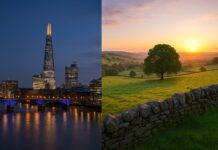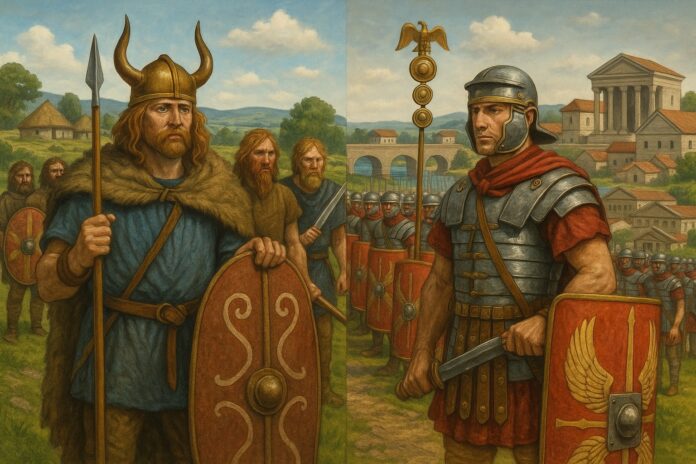Journey into the mysterious world of Pre-Roman and Roman Britain, where ancient Celtic tribes, sacred landscapes, and powerful Roman legions shaped the origins of Britannia. This article uncovers archaeological discoveries, lost settlements, and the dramatic cultural shift that followed the Roman conquest of Britain. Rich with historical insight and vivid detail, it reveals how Rome transformed a land of warriors and rituals into a thriving province that laid the foundations for Britain’s future.
Across the windswept moors, ancient forests, and rugged coastlines of Britain, echoes of forgotten worlds linger. Long before paved Roman roads stretched across the countryside, the island was home to powerful tribes, intricate belief systems, and vibrant cultures that thrived in rhythm with the land. These whispers of pre-Roman Britain survive in stories, artefacts, and landscapes that continue to fascinate historians and travellers alike. For many, to travel through these ancient places is to step into the living echoes of a world long past.
When the Romans arrived in AD 43, they encountered a world unlike any they had known. Their occupation reshaped Britain’s identity through new technologies, governance, architecture, and social systems. Yet the island’s older voices never disappeared. Instead, they blended with Roman influences to create a unique cultural tapestry that modern archaeology continues to unravel layer by layer.
The Mystery and Allure of Pre-Roman Britain
Land of Tribes and Ancient Beliefs
Before the Roman conquest, Britain was dominated by Celtic tribes, including the Iceni, Brigantes, Trinovantes, and Silures. Each tribe had its own territories, hierarchies, warriors, and belief systems. Life was deeply connected to natural forces, with rivers, groves, and stones playing key spiritual roles. Druids were central figures—keepers of knowledge, law, and ritual, rumoured to possess significant influence.
Early Settlements and Daily Life
Pre-Roman communities lived in roundhouses built of timber and thatch, often clustered within fortified hillforts. These settlements were not primitive but organised and dynamic. Farming was central to survival, and craftsmanship in bronze, iron, and jewellery was highly developed. Trade routes linked Britain to Ireland and mainland Europe long before the legions arrived.
A Landscape Filled with Meaning
The land itself was a sacred map. Stone circles, burial mounds, and earthworks revealed a society with a strong connection to ancestry and cosmology. Sites like Maiden Castle, Avebury, and Silbury Hill remind us that these ancient people engineered massive structures with remarkable skill and purpose.
The Roman Invasion and Its Transformative Impact
The Conquest Begins
The Roman invasion began under Emperor Claudius in AD 43, bringing professional soldiers, advanced weaponry, and strategic expertise. Some tribes submitted peacefully, while others fiercely resisted. The revolt led by Boudica of the Iceni remains one of the most dramatic chapters in Britain’s ancient history, symbolising defiance against imperial power.
A New Order Takes Shape
Roman occupation reshaped almost every aspect of daily life. Urban centres emerged, complete with forums, baths, and amphitheatres. Latin became the language of administration, while currency and taxation integrated Britain into the empire’s vast economic network. Roads, bridges, and aqueducts changed movement and trade forever.
Cultural Exchange and Integration
Although the Romans brought their own gods, laws, and customs, they also absorbed elements of Celtic tradition. Many Britons adopted Roman clothing, architecture, and food, while maintaining their own local identities. This cultural fusion created a unique provincial blend, evident in religious artefacts that combine Roman and Celtic motifs.
Archaeological Discoveries That Reveal Ancient Lives
Forts, Walls, and Military Might
Hadrian’s Wall stands as one of the most iconic reminders of Rome’s northern frontier. Excavations reveal barracks, granaries, and temples that show the daily routines of soldiers posted far from home. Sites like Vindolanda have produced thousands of handwritten tablets, offering rare glimpses into personal lives, shopping lists, complaints, and family letters.
Villas and Rural Prosperity
Roman villas uncovered across southern Britain display elegant mosaic floors, underfloor heating, and sophisticated design. These estates reveal how Romanised elites lived, blended local traditions with Mediterranean luxury, and managed vast agricultural operations to support the province’s economy.
Coins, Pottery, and Everyday Objects
Minor artefacts often tell the most personal stories. Coins trace political change, trade routes, and local circulation. Pottery fragments reveal domestic habits, food culture, and craftsmanship. Burial sites, including both Roman cremations and Celtic inhumations, offer clues to spiritual beliefs and social status.
Forgotten Voices Unearthed
From intricately carved torcs to mysterious ritual deposits in rivers, artefacts illuminate the lives of people whose stories rarely appear in written records. These finds highlight a world where myth, craft, war, and survival are intertwined.
Comparing Pre-Roman and Roman Britain
Technology and Innovation
Pre-Roman societies used iron tools and weapons but lacked large-scale infrastructure. The Romans introduced stone roads, concrete, large buildings, and advanced engineering. Their innovations turned scattered tribal lands into an interconnected province.
Religion and Worldview
Celtic spirituality was rooted in nature and oral tradition. The Romans brought structured pantheons, temples, and eventually Christianity. Over time, these blended into hybrid practices, as evidenced in archaeological remains.
Warfare and Defence
Tribal warfare relied on chariots and local fortifications. Roman armies used disciplined formations, heavy infantry, siege weapons, and sophisticated military strategy, giving them a decisive advantage.
Lifestyle and Culture
Daily life shifted from rural tribal settlements to bustling towns and villa estates. Roman Britain became a multicultural society, influenced by the empire’s diverse regions.
Enduring Echoes: How the Past Shapes Britain Today
Modern Britain still carries the marks of these ancient worlds. Place names preserve Celtic roots, while Roman roads influence the shape of today’s highways. Museums hold treasures that reveal how identity evolved through conflict, exchange, and adaptation.
The whispers of pre-Roman and Roman Britain remind us that history is not a distant story; it is woven into the landscapes we walk, the language we speak, and the heritage we share. Understanding these past worlds deepens our understanding of what Britain has become and the cultural journeys that shaped it.
Frequently Asked Questions
1. What was Britain like before the Romans arrived?
Pre-Roman Britain was home to diverse Celtic tribes with their own languages, customs, and belief systems. Communities lived in roundhouses, traded widely across Europe, and developed impressive metalwork and fortified settlements. Their society was closely linked to nature, spirituality, and ancestral traditions carried through oral storytelling.
2. Why did the Romans invade Britain?
The Romans invaded Britain to expand their empire, secure valuable resources, and strengthen their political influence in Europe. Britain offered metals like tin and lead, as well as strategic trade opportunities. The conquest also enhanced Emperor Claudius’s reputation, marking a significant military achievement for Rome.
3. How did Roman rule change daily life in Britain?
Roman rule introduced new towns, roads, laws, and technologies that transformed everyday life. People gained access to paved streets, public baths, markets, and coin-based trade. Cultural exchange blended Roman customs with local traditions, creating a new hybrid society that shaped Britain’s long-term development.
4. What are the most important archaeological discoveries from Roman Britain?
Major discoveries include Hadrian’s Wall, the Vindolanda tablets, Roman villas with stunning mosaics, and countless coins and pottery fragments. Each find reveals details about military life, social status, trade, religion, and domestic routines. These artefacts help historians reconstruct how people lived across different regions.
5. How did Celtic and Roman religious beliefs differ?
Celtic religion revolved around natural elements such as rivers, groves, and sacred stones, guided by druids. Roman religion featured an organised pantheon, temples, and state rituals. Over time, both belief systems blended, resulting in hybrid practices and shared symbols found in temples and artefacts across Britain.
6. Are there still visible traces of Roman Britain today?
Yes, many traces remain, including sections of Roman roads, walls, bathhouses, amphitheatres, and fort ruins. Modern city layouts often follow Roman planning principles. Museums across the UK house artefacts that bring this ancient period to life, allowing visitors to explore Britain’s layered archaeological heritage.
7. How have these ancient periods influenced Britain’s identity?
Both pre-Roman and Roman Britain shaped the country’s cultural foundations. Celtic traditions influenced language, folklore, and place names, while Roman innovations affected governance, infrastructure, and trade. Together, they created a rich historical legacy that continues to inform Britain’s sense of heritage and national identity.
Conclusion
Exploring pre-Roman and Roman Britain reveals how deeply layered the island’s Britain history truly is. From tribal societies shaped by nature and tradition to a Roman world built on structure, engineering, and cultural exchange, each era added something distinctive to Britain’s evolving character. What emerged was not a story of replacement but of blending old beliefs with new ideas, of local customs absorbing imperial influence, and of communities adapting to change while holding on to their identity.
These ancient voices still echo today in place names, landscape features, road networks, and the archaeological treasures uncovered each year. They remind us that modern Britain is rooted in centuries of transformation, resilience, and cultural fusion. As we continue to study these early periods, we uncover not just artefacts but also more profound insights into how identity forms and societies evolve.
The past is far from silent. Its whispers encourage us to look closer, question more, and remain curious about the stories still waiting beneath the soil, each discovery offering another piece of the puzzle that shaped the Britain we know today.




























